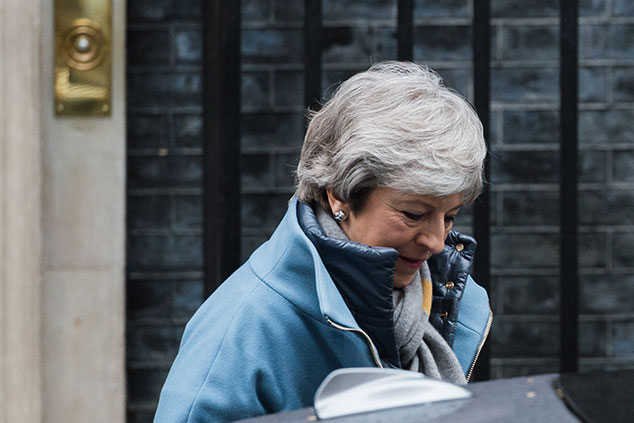
“It was once rare for British governments to lose big votes in the House of Commons,” says The Economist. “Under Theresa May it is becoming a habit.” On Tuesday, her Brexit deal was “roundly rejected” by 391 votes to 242. Although she has clawed back 40 votes since the first “meaningful vote” on 15 January, this is “still a huge loss by historical standards”.
The defeat came after Attorney General Geoffrey Cox advised that, despite a last-minute dash to secure legally binding documents from the EU over the Irish backstop, ultimately, the “risk remained” that Britain could find itself stuck with it, trapping the UK indefinitely inside a customs union.
The next steps
On Wednesday, as MoneyWeek went to press, the Commons was expected to vote by a large margin against a “no-deal” Brexit; a day later, for an extension to the 29 March deadline. “Somewhat grudgingly”, EU leaders will probably agree to this at a 21-22 March summit, although to avoid Brexit getting “entangled in the Europe elections in late May”, they will limit the extension till then. “What will happen during those two months is less clear.”
Aside from the “fudge and delay” scenario, unscheduled developments are a possibility, says Paul Dales in Capital Economics. “Something could force May to resign and/or the Labour party could try to trigger a general election.” The good news, however, is that despite all the uncertainty, the economy is “holding up well”. The UK is growing at a faster rate than Germany, France, Italy and Japan. Lingering uncertainty won’t help, but even so, the economy is “well placed” for a Brexit deal and would “cope” with a no-deal “better than most expect”.
The trouble is that there hasn’t yet been a sense among MPs that this is “really, truly, the last chance saloon”, says Anand Menon in The Guardian. “Deadline day depends on a fixed deadline that everyone accepts.” European Commission president Jean-Claude Juncker has been clear that the EU will not reopen negotiations,
and that an extension would only be till May. Maybe this is the real deadline. Brexiters will have to decide if they prefer May’s deal to no Brexit at all. Labour MPs opposed to another referendum will have to decide whether to back the deal or “swallow” a second popular vote. At this point – remarkably – a majority “may be within grasp”.
It may be, agrees Robert Shrimsley in the Financial Times. As May reminded MPs this week, they still need to “choose a deal they can support”. Indicative votes may follow to allow MPs to “direct the future course of Brexit deliberations”. None of this bodes well for hardliners.
To “ratchet up the pressure, the government will publish papers on no-deal tariffs and arrangements for the Northern Ireland border. None will be pretty.” The hardliners’ nerve is already beginning to crack. They were desperate for Cox to provide the “cover” they needed to “climb down”. “They know that once the other side coalesces around an alternative soft-Brexit plan or referendum, the momentum may prove unstoppable.” Once the Commons seizes control of the process, May may struggle to reclaim it. “All Brexit outcomes remain possible, but “one last heave for her deal is also still in the mix”.
The Speaker may rule out a third vote if it is not materially different from the last, says Philip Johnston in The Daily Telegraph. And the EU won’t offer concessions once the “threat of disruption to EU trade from a disorderly no-deal Brexit” has been “taken off the table”. Brexit Britain needed a visionary PM and we got a pragmatist. It’s time she went.
Fiscal Phil finds a war chest
The Chancellor’s spring statement was “always going to be a sideshow” given this week’s votes on Brexit, but Philip Hammond managed a “small surprise” by announcing some “spare funds” provided a Brexit deal is agreed, says Paul Dales in Capital Economics.
Although Hammond did downgrade OBR (Office for Budget Responsibility) GDP growth for 2019 to 1.2% from 1.6% last year, upward revisions in later years (1.4% in 2020 and 1.6% from 2021-2023) leave the average growth rate “almost unchanged”. The “real boost” to the public finances comes from assumptions such as increased wage growth and, adds The Daily Telegraph, a downgrading of borrowing forecasts after a “bumper tax haul” in January. Borrowing for the ten months of this fiscal year stands at £21.2bn, its lowest level for 17 years.
This is good news, says Ian Stewart, Deloitte’s chief economist, on the BBC. And with Brexit looming, the Treasury needs a war chest. But we should not forget that“the burden of debt in the UK is still at its highest in over 50 years”.
So what did fiscal Phil’s mini-Budget include? A review of the National Minimum Wage, a new £3bn affordable homes scheme and £100m of extra funding to fight knife crime, says Sophie Smith in The Daily Telegraph. There will be a consultation on how to replace PFI (private finance initiative) contracts and a review of the global tech giants to ensure they pay their fair share of tax.
Although Hammond’s plan is “to restart the fiscal squeeze” after 2019/20, he is likely to “ease up” nearer the time, given the government’s slim majority and the fact that cyclically adjusted borrowing is still “well below” his self-imposed target, says Samuel Tombs in Pantheon Macro-economics. Since there is “little appetite” for more austerity, fiscal policy will no longer “dampen the economy”, strengthening the case for an interest rate rise once Brexit uncertainty has faded.